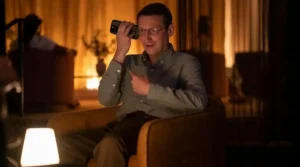It’s Jane Wick.
Okay, sorry, that’s not entirely accurate. But I’ve had that joke lined up since the first trailer, and while it might not be my best work, I needed to get it off my chest. It’s half right, anyway. Atomic Blonde is about a badass super-spy punching, shooting and stabbing her way through a stylized aesthetic under the direction of David Leitch. Certainly sounds like John Wick to me.
But, alas, Atomic Blonde isn’t that – at least not all the time. In reality, it’s based on a moderately obscure graphic novel, The Coldest City, and takes the form, structurally and tonally, of a twisty Cold War espionage thriller full of Soviet skulduggery and collapsing communist regimes. Which isn’t exactly what was advertised.
Oh. So, what’s the plot?
Picture the scene: Berlin, 1989. The wall is coming down. The Cold War is thawing out. There’s an East German defector with a head full of knowledge, a dead British covert operative, and a microfilm hidden in a wristwatch that contains the kind of glacial intelligence that could freeze East and West right back up again. Multiple competing parties want The List, nobody is who they say they are, and they couldn’t be trusted even if they were. I wasn’t born in the 80s, and I’ve never been to Germany, but according to every movie ever, this is just how things were.
As MI6 agent Lorraine Broughton, Charlize Theron is despatched to Germany by a team of suits (including John Goodman and Toby Jones) to smoke a lot of cigarettes in lingerie while backlit by gaudy neon lamps. And also, while she’s at it, to retrieve the List and get James McAvoy’s “gone native” deep-cover operative back on the straight and narrow. Exactly how straight and how narrow one can be in that line of work is mostly the point of the movie.

Wait… that’s the point?
Indeed. I wouldn’t go so far as to say we were sold a lie, but it seems fitting for this kind of story that we were sold a slight mistruth. I guess it’s hard to market quiet scenes of characters lying to each other, recognising that they’re both lying, and continuing to lie anyway, and Atomic Blonde has a lot of that. It isn’t that this stuff is any less worthwhile than the action, in theory, but the double- and triple-crossing isn’t as clever or interesting as it could be, especially in the first act, and if it weren’t for the visuals and the New Wave pop needle-drops that whole stretch would be kind of a drag.
But it gets better?
It gets more assured, certainly, and the movie starts to feel freer once it moves past all the frontloaded scene-setting exposition. The plot never really rises above generic, though, and because so much time is devoted to setting up reveals that are kind of obvious, you do tend to frequently notice quite how generic it is.
Is that a dealbreaker?
Not at all, but it’s noticeable all the same, and is the main thing that repositions Atomic Blonde as a slightly different experience than John Wick, which trusted the audience to fill in the world-building blanks on their own. Being unlike John Wick is not a criticism in itself (it is), even though the movie was explicitly marketed on that basis, and I imagine I wouldn’t even be writing this paragraph were Atomic Blonde’s plot better, or at least less pedestrian. Here we are, though. The movie does provide a livener in the form of Sophia Boutella, as a fellow agent assigned to the same case, and in a pleasantly refreshing turn of events, the romance she conjures with Theron’s character is barely remarked upon. How this kind of thing usually works in a theatrical action movie – or, let’s be frank, a theatrical movie, full stop – is one of the characters explicitly discusses their sexual orientation, or says something along the lines of, “I’ve never been with a woman before,” and McAvoy’s character would probably watch them kiss through a window with a hand in his pocket. Thankfully, Atomic Blonde has none of that.
But it does have action?
Oh, plenty, and thank goodness for it. Despite Theron’s character often being naked (she has a predilection for ice baths, for no reason that I can identify) the real selling point here is how she acquits herself in the action sequences, of which there are several, any one of which probably superior to any other you’ve seen this year. Don’t imagine the elaborate gun-fu of John Wick, though; Atomic Blonde differs even in that respect, instead favouring hand-to-hand, room-to-room choreography that has a heftier, more realistic physicality than the Raid movies, but a similarly brutal appeal. Theron wears every blackened eye and split lip, too; a macabre wrinkle of continuity that you see rarely in action movies, and almost never in those led by women.
What it most reminds me of is Steven Soderbergh’s Haywire, a martial arts thriller full of preposterous nonsense that saw retired MMA fighter Gina Carano act alongside a litany of surprisingly big names. Atomic Blonde holds up slightly better under scrutiny, but it’s just as reliant on grounded action to elevate thin material.

Did you like Atomic Blonde?
I did, but I wish very much that it gave me a reason to like it more. Theron’s leading performance is that of a true movie star, and the ones around her (including McAvoy’s manic British rogue, and Boutella’s latest pastiche of a Bond archetype) bolster the idea that this is a project made by talented, enthusiastic people. Kurt Johnstad’s screenplay begs to differ, though, littered as it is with tropes, cliché, and a dogged lack of insight or intelligence. If this were the movie that was advertised, none of that would matter. But Atomic Blonde is a Cold War thriller with action scenes, not an action movie with a Cold War subtext; no matter how good the action is (and it’s unequivocally excellent), it isn’t enough.
Atomic Blonde is an exploitation thriller with a baked-in trashiness, and it’s hard to reconcile some of its glibber stylistic flourishes with even earnest attempts at depth. Theron’s character – whose unflappable exterior, as beaten and bloody as it ends up being, is the most notable thing about her – at one point, after single-handedly brutalizing what seems like Berlin’s entire police force, says that had she known about the impending fistfight, she would have worn a different outfit. The whole film talks like that; knowingly, smugly. It believes acknowledging its own derivativeness is a defence against it. But, in the same movie, we’re expected to buy into long speeches about the enduring legacy of totalitarianism, the (literal) collapse of ideological divides, and the meddlesome tendencies of Western foreign policy. By the time all is revealed, and who’s working for whom is explained, you still get the sense that nobody knows why they’re doing anything besides the script having told them to.
So, do you recommend it?
Cautiously. There’s novelty in watching one of the world’s most beautiful and physically-striking stars get the shit kicked out of her, and in a late-summer movie being so morally chilly, and in deeply unpleasant people plying a cynical trade in a movie that is so flagrantly designed to be flashy and diverting. There’s a fight scene which moves from a stairwell to a speeding car to a frozen river in a single long, unbroken take, which might be the most believably-acted and choreographed of such things in recent history. These things are all worth seeing.
Very little else is. The plot is leaden with tropes and cliché, muddled by hollow political twaddle, and about half as clever as it needs to be. If you’re here for Charlize Theron, and for industry-standard-setting action – which is, mostly, what I was looking for – then Atomic Blonde is for you. If you’re looking for anything else, you probably won’t find it here. Just read a John le Carre novel instead.




